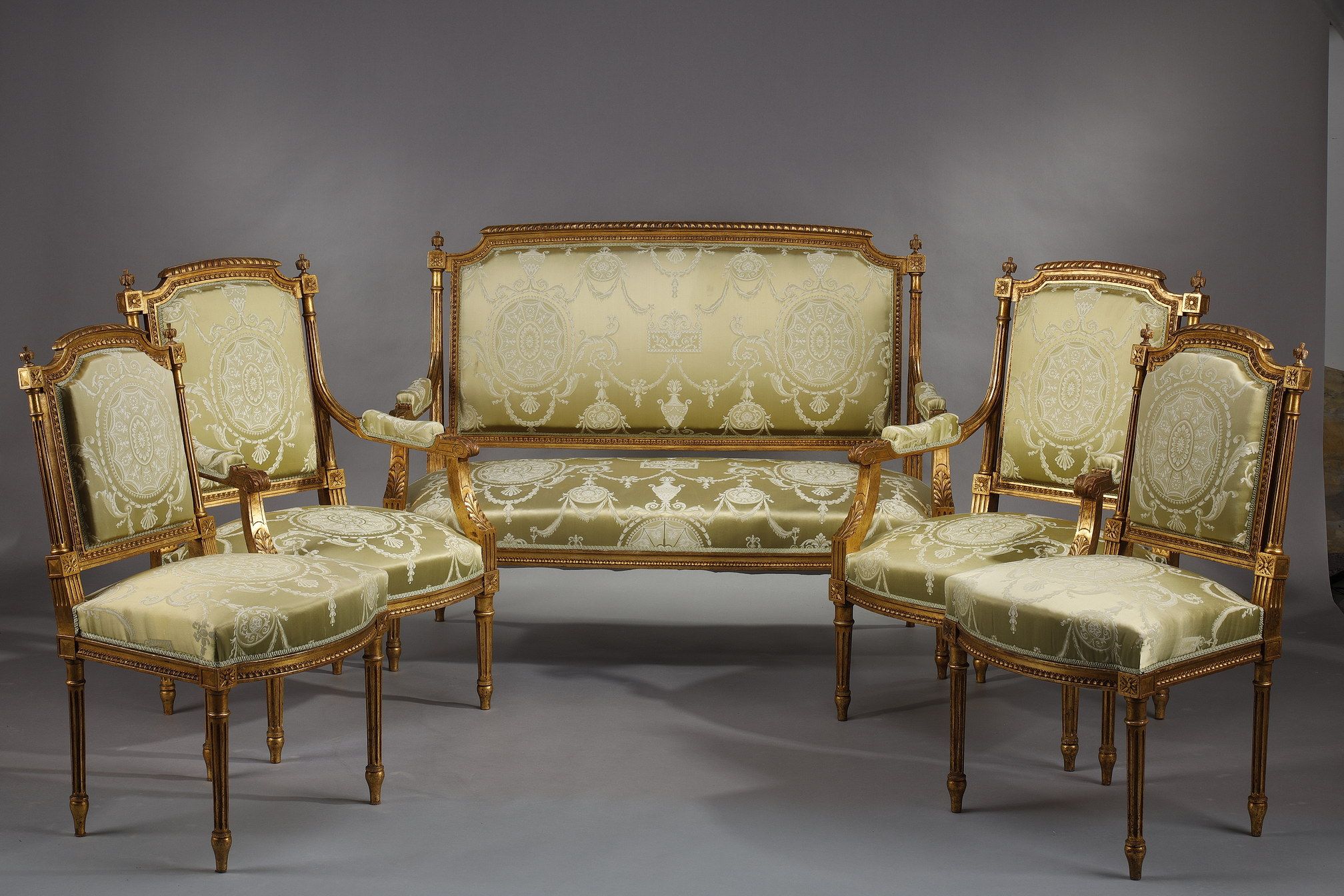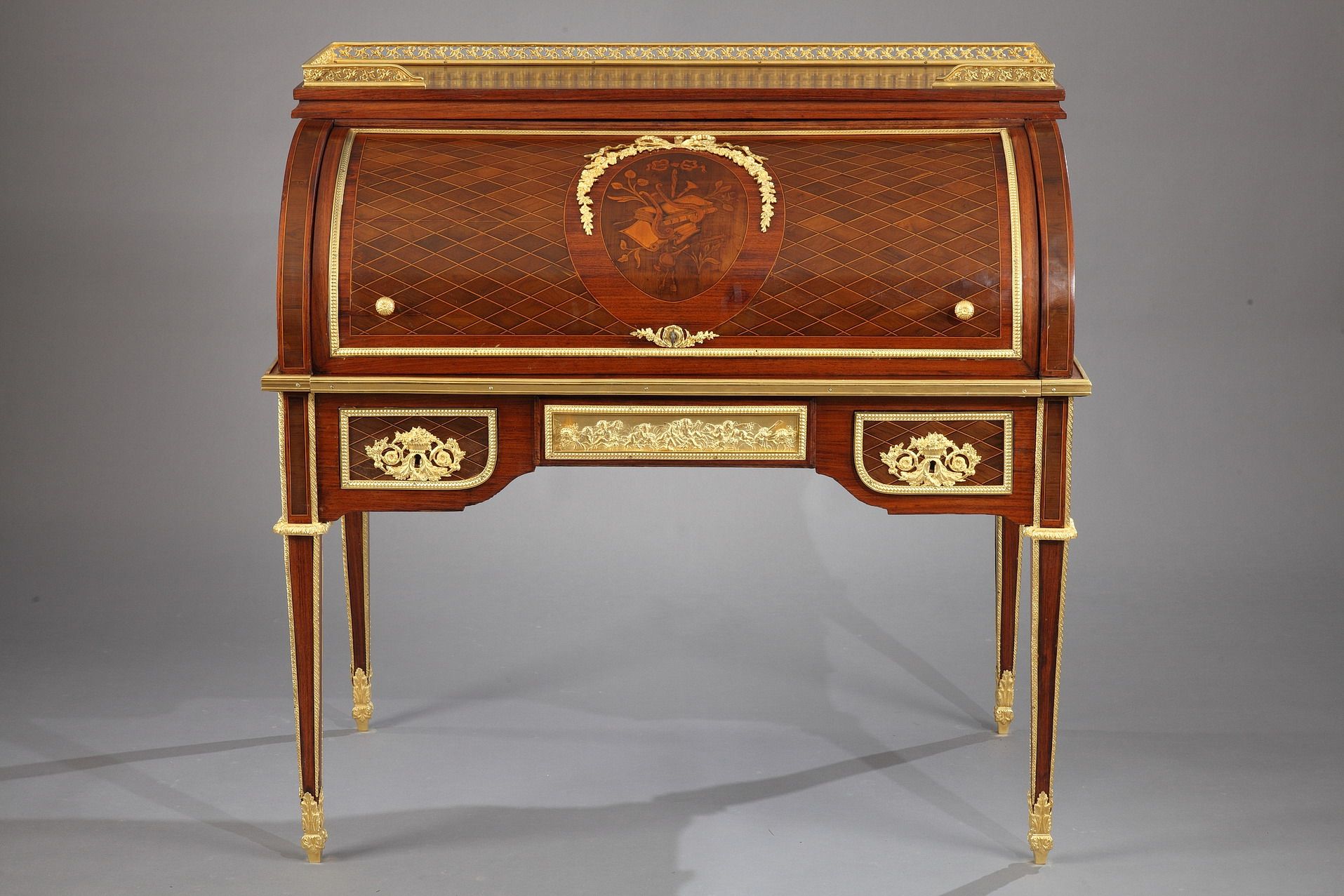After the research period of the Transition style (1765-1775), the Louis XVI style asserted itself in the early 1770s as the elegant expression of a return to classicism, free from the rigorism of the "Greek" taste and the exuberance of the Rocaille style. The archaeological discoveries of Pompeii and Herculaneum from the late 1730s onwards inspired the decorative arts and revived interest in the antique style.
 Louis XVI style gilt bronze "Venus on her chariot" clock
Louis XVI style gilt bronze "Venus on her chariot" clock
Furniture and interior design
Although Louis XVI's tastes were rather simple, Marie-Antoinette loved luxury and devoted herself to decoration, an area in which she intended to set the tone. In particular, she builded appartments in the royal residences of Versailles, the Tuileries, Compiègne and Fontainebleau, which she decorated and furnished by commissioning the greatest representatives of the crafts of her time.
 Louis XVI salon in gilded wood and green silk
Louis XVI salon in gilded wood and green silk
Jean-Henri Riesener, probably the most talented cabinetmaker of his time, worked almost exclusively for the Queen. He created furniture distinguished by its elegant proportions, the quality of the materials used and the excellence of its craftsmanship.
Cylinder desk after a Riesener model attributed to the Maison Beurdeley
Adam Weisweiler, a German cabinetmaker whose reputation in the European courts was considerable, was invited by the Queen to Paris. He settled in rue du Faubourg-Saint-Antoine, the center of 18th-century cabinetmaking, where he produced small-scale furniture, including numerous tables.
Among the best-known carpenters were Georges Jacob, supplier to the Garde-Meuble from 1774, and Jean-Baptiste Séné, who also obtained the title of supplier to the Garde-Meuble in 1785.
The Louis XVI style retained some of the multi-purpose furniture of the Louis XV style, whose lines lost their movement to gain in straightness and sobriety. Generally speaking, from the 1770s onwards, all furniture abandoned the predominance of curves to adapt to the Greek style. Flat surfaces and right angles came back into fashion. Ornamentation intervenes to soften this severity, without ever interrupting the line and respecting absolute symmetry in relation to the median axis.
A number of modifications and new features have been added. The tops of oval or round pedestal tables and some small serving tables are encircled by a copper gallery.
The cupboards have a fine moulded cornice, sometimes straight. The lower rail is almost always cut, moulded or carved; the legs are bracket or roquillard. Most often a Greek frieze, wreaths of flowers, foliage and acanthus is mixed with rows of pearls and fluting.
 Pair of walnut and marble consoles in the Louis XVI style
Pair of walnut and marble consoles in the Louis XVI style
The straight, smooth chest of drawers is still a feature of living rooms. Consoles and corner pieces in walnut or fruitwood are matched, and half-moon models are also available. Straight secretaries with flaps, adorned with rich Japanese or European marquetry or lacquer, are also very popular.
The Louis XVI style seats are particularly elegant. The backrests have a variety of unusual shapes: hat-shaped, racket-shaped, lyre-shaped, sheaf-shaped and above all medallion-shaped, the typical cabriolet backrest.
Precious objects, pieces of silverware and porcelain, marble or bronze statuettes, candlesticks, sconces and, above all, numerous gilded and patinated marble and bronze clocks are placed on mantels and furniture to liven up the decor.
Ornamentation
The Louis XVI style returns to the antique repertoire: friezes of Greek, rosettes, pearls, oves, baguettes, interlacing, laurel or acanthus leaves with regular contours, and finally the medallion, always oval, decorated in its upper part with a ribbon bow. The straight line returns in force and is omnipresent. There are no more sinuosities: only semi-circles and ellipses are tolerated.
 Impressive pair of Louis XVI sconces by Thomire
Impressive pair of Louis XVI sconces by Thomire
However, this classical repertoire lacks the rigor of the very formal Greek style. In its first part, the Louis XVI style combines antique elements with floral motifs, palmettes and garlands of flowers and foliage, inspired by the return to nature so appreciated by Marie-Antoinette.
Under his impetus, decoration was enriched with flowers, floral baskets, musical and country attributes, ribbons and ribbon bows. Moreover, to prevent the antique style from becoming too dry, cabinetmakers tempered it with light Roman-style friezes in chased gilded bronze and graceful arabesques inspired by Etruscan paintings.
Among the decorative motifs characteristic of the style are objects found in excavations: vases, urns with rectangular handles, tripods, perfume dishes, fire pots, dentils and rosettes are also borrowed from Antiquity, as are eagles, dolphins, ram heads, lions, chimeras, mermaids and griffins.
 Important pair of marble cassolettes in the Louis XVI style
Important pair of marble cassolettes in the Louis XVI style
The artists of the period knew how to marry these various influences with lightness and parsimony: decorations are more measured, flowers don't invade the surface but are woven into garlands or presented in baskets, bronzes are lighter.
The iconography of the trophies is appreciated, with a variety of themes: war trophies, but also music trophies and even scientific instruments. The taste for the Orient continued and merchants commissioned cabinetmakers to make furniture in Japanese lacquer and European varnish.
The "antique style", sometimes referred to in its most typical refined expression as the "Marie-Antoinette style", extended beyond the reign of Louis XVI (1774-1791), spanning more than half a century to the end of the Empire.



